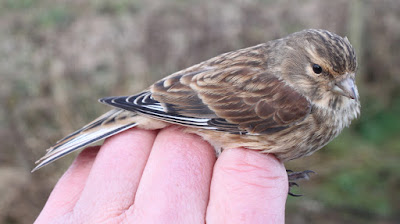Luckily, and after studying the weather forecast I’d prepared well with a good breakfast, double socks and outdoor clothes warming over the kitchen radiator. Minus four (-4°) flashed the temperature gauge as I set off towards Pilling to meet Andy for 0800 at Gulf Lane where we hoped to catch more Linnets.
We set the usual 3x single panel nets in the frosty, low vegetation and retired to the car for a coffee or two until the birds arrived. Initially the Linnets seemed not to visit the seed heads in the field of set-aside but to instead spend time perching along the roadside barbed wire fence that faced into the slowly rising sun.
A good number of them also spent time in the roadway taking grit from the surface until approaching cars forced them to fly off. Grit is eaten a lot by seed eating birds. The grit accumulates in the gizzard and helps to break down any tough seeds by abrasive action to make the seed more easily digested. Remember, birds have no teeth with which to munch their morning muesli.
Linnet
The Linnets were well up to recent numbers by way of an estimate of 250+ individuals sticking to two or three distinct flocks that split and then re-joined after being disturbed by passing vehicles, or often, an unknown cause. There was a Kestrel sat atop a distant tree that kept watch on proceedings and in the course of a few hours made two unsuccessful passes to grab a Linnet, a distraction that probably helped the flock to become increasingly jumpy and nervous of feeding. Or perhaps the Linnets were waiting for the overnight frost to clear a little before they began their breakfasting?
Kestrel
Frosted Linnet field
We didn’t catch well with just eight new Linnets, although that increased our project catch to over 130 so far this autumn/winter. As the winter deepens it could be that the Linnets all depart, and even though there is plenty of natural food left for them to go at, the plants are now at virtual ground level which makes it more difficult to intercept them in flight.
Do we carry on with minimal but perhaps catches of less than ten birds each time? It’s up for discussion but on balance we probably should continue as lowland wintertime Linnets are not caught in any great numbers in the UK, and certainly not in this part of northwest England.
Linnet
Linnet
Any data we collect will add to that already in existence and hopefully give a little more insight into the origins, movements and composition of both individual Linnets and Linnet flocks.
Other birds seen at the set-aside, but more correctly in the attached drainage ditch today – 1 Little Egret, 6 Snipe and 1 Teal.
Little Egret























































.jpg)











